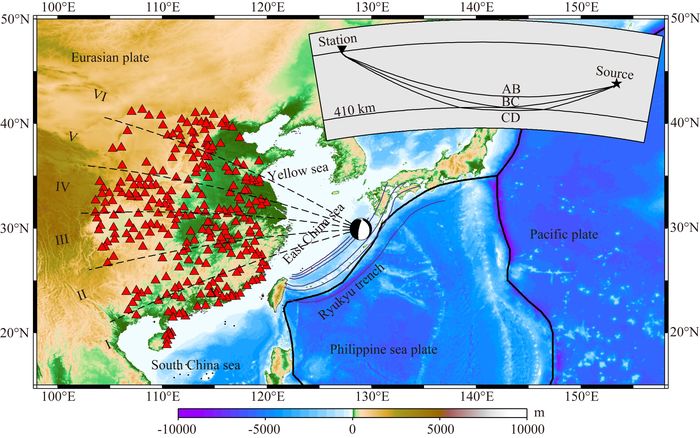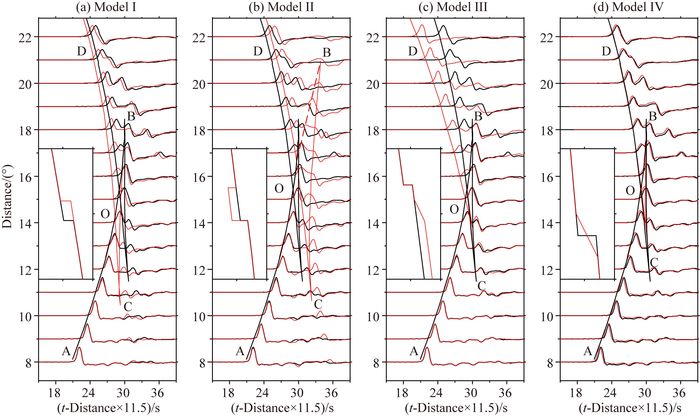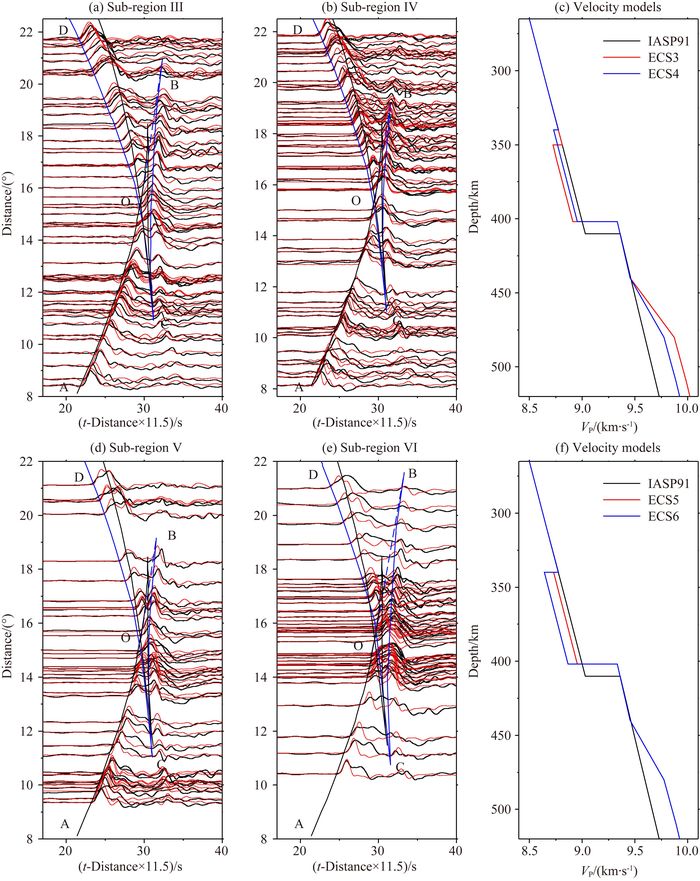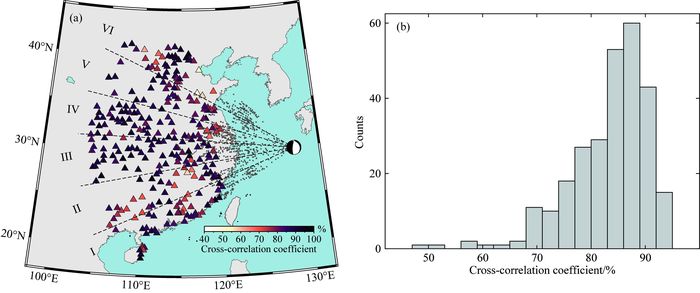2. 中国科学院计算地球动力学重点实验室, 北京 100049;
3. 柏林自由大学地球科学学院, 柏林 14195
2. Key Laboratory of Computational Geodynamics, Chinese Academy of Sciences, Beijing 100049, China;
3. Department of Earth Sciences, Freie Universität Berlin, Berlin 14195, Germany
410 km间断面(以下简称410)作为地幔转换带的顶界面, 其结构和起伏形态可以有效表征该间断面附近的地幔物质组成和温压特征.对410的精细结构开展地震学研究有助于我们理解区域地幔物质循环过程, 包括岩石圈俯冲及拆沉, 地幔矿物脱水和地幔热物质上涌等地球动力学过程.一般认为, 410是橄榄石到瓦兹利石(α→β)的相变面(Ringwood, 1991; Frost, 2008; Deuss, 2009).410在全球平均参考模型PREM(Dziewonski and Anderson, 1981)、IASP91(Kennett and Engdahl, 1991)和AK135(Kennett et al., 1995)中均显示为地震波速度和密度的跃变界面.地幔温度和含水变化会影响410在地球内部的起伏形态.由于橄榄石-瓦兹利石相变属于放热反应(dP/dT>0), 当地幔温度偏低时相变界面深度变浅(Tonegawa et al., 2005; Gao et al., 2010); 而当地幔温度偏高时相变界面深度加深(Helffrich, 2000; Collier et al., 2001; Deuss, 2009).高温高压矿物实验证实在近似水饱和环境下橄榄石-瓦兹利石相变面要浅于无水环境(Smyth and Frost, 2002); 在富含水的地幔中410的相变界面深度会变浅且相变区间变宽(Wood, 1995).此外, 高含量的Fe和Al分别能导致浅而宽和深而窄的410; Mg-Fe在橄榄石-瓦兹利石和石榴子石之间的分配作用也可导致橄榄石-瓦兹利石相变区间变小(周春银等, 2010).
地震波能带来地球深部速度结构的大量信息.近二十年来, 地震学家陆续报道了在全球范围内多个地区410上方存在低速层的现象, 但其厚度和速度异常大小不一.Revenaugh和Sipkin(1994)利用ScS多次波研究发现日本海和黄海地区410之上存在厚度为80 km的低速层, S波速度降约为5.8%; Tauzin等(2010)利用接收函数研究揭示了410上方低速层在全球范围内是普遍存在的.前人通过对高密度地震台网资料进行波形拟合, 发现美国西北部(Song et al., 2004)、日本本州北部(Obayashi et al., 2006)、下扬子克拉通(李国辉等, 2014)、中国东部海域(眭怡和周元泽, 2015)以及中天山和塔里木盆地北部(高雅健等, 2017)等地区410上方存在低速层.引发地幔转换带顶部低速层形成的因素可能有与地幔深部物质上涌有关的热异常(Obayashi et al., 2006)以及地幔橄榄岩的部分熔融(Revenaugh and Sipkin, 1994; Song et al., 2004; 李国辉等, 2014; 高雅健等, 2017).诱发上地幔矿物部分熔融的重要因素是挥发分物质, 包括地球深部的水和以碳酸盐岩形式存在的CO2(周晓亚等, 2014).地球深部水的来源有三种可能性:俯冲到地幔转换带附近的板片中含水矿物脱水、地幔柱上升过程中含水硅酸盐脱水以及地幔转换带的水在水过滤过程中产生的水聚集(Bercovici and Karato, 2003; Ohtani, 2005; 李国辉等, 2014).
中国东海地区位于欧亚板块与菲律宾海板块的结合地带, 受到了太平洋板块和菲律宾海板块俯冲的影响(Wang et al., 2017;江为为等, 2004).地震层析成像结果显示, 菲律宾海板块在琉球海沟处俯冲于欧亚板块下方, 最大俯冲深度约为300 km(Li and Van Der Hilst, 2010; Fukao and Obayashi, 2013), 而其在日本西南部地区的最大俯冲深度仅200 km(Nakajima and Hasegawa, 2007); 西太平洋板块在伊豆—小笠原海沟处俯冲于菲律宾海板块下方, 并在地幔转换带内停滞于660 km间断面(以下简称660)之上而形成了滞留板片(stagnant slab), 一直延伸至中国东海地区以至扬子地块和华北克拉通东部(Van Der Hilst et al., 1991; Huang and Zhao, 2006; Chen and Ai, 2009).前人三重震相研究结果表明, 东北亚地区滞留的太平洋俯冲板片厚度可达140±20 km, 预示了俯冲板片在地幔转换带底部会发生堆积和变形过程(Tajima and Grand, 1995; Wang et al., 2006; Wang and Niu, 2010; Zhang et al., 2012; Li et al., 2013; 崔辉辉等, 2016); 同时, 俯冲板片带去的低温可导致410出现抬升, 如在日本列岛地区(Tonegawa et al., 2005)和中国东北及朝鲜半岛地区(Gao et al., 2010).
受限于海洋地区布设地震仪器的成本, 中国东海地区地震台站较少, 因此缺乏对该地区深部结构的直接观测.基于高密度台网/台阵资料的波形拟合能够有效探测地幔深部速度结构, 并对地幔间断面的存在形态提供有效约束.本文利用中国数字地震台网(China Digital Seismograph Network, CDSN) (郑秀芬等, 2009)记录到的位于琉球俯冲区一个中源地震的P波宽频带波形资料, 通过对观测三重震相进行不同速度模型的合成波形拟合研究中国东海地区410附近的精细速度结构, 分析板块深俯冲对区域速度结构的影响和含水矿物脱水对410起伏的作用, 并着重探讨其上方低速层及其可能成因.
1 方法和数据 1.1 波形模拟测试地震波场能够直接从地球深部带来与地下介质速度结构有关的重要信息(Helffrich, 2000).波形拟合方法通过计算理论波形并对地震波场中各震相的波形以及震相间的相对到时进行匹配分析, 以获取地下介质速度分布.目前波形拟合方法已广泛应用于不同尺度地球内部速度结构的探测(Tajima and Grand, 1995; Wang and Chen, 2009; Chu et al., 2012; Sun et al., 2014).
对于地幔间断面(如410)而言, 由于存在速度跃变, 地震波在通过该界面时会产生三重震相现象, 相应的走时曲线会发生回折.如图 1中右上角插图所示, 三重震相包括间断面之上的回折波AB, 间断面上的反射波BC和间断面之下的回折波CD.由单个台站记录的AB、BC和CD的射线路径在上地幔浅部大致相同, 其差别主要集中在间断面附近(叶玲玲和李娟, 2012), 因此采用密集台网/台阵所记录的三重震相资料能在一定程度上有效降低浅层横向非均匀性对局部台站记录波形和走时的影响(Chen and Tseng, 2007; Wang and Niu, 2010; Zhang et al., 2012; 崔辉辉等, 2016).对多重波至之间相对到时和振幅变化进行波形拟合可以有效地约束地幔间断面的形态及其附近的速度结构(李国辉等, 2014).

|
图 1 本文所用地震事件和台站位置图 台站(红色三角)以13°方位角间隔均分为6个子区域(Ⅰ—Ⅵ).黑色线为板块边界(DeMets et al., 1994).灰色线表示琉球俯冲带等深线(Gudmundsson and Sambridge, 1998).右上角插图为410 km间断面附近三重震相射线路经图, 包括地震射线AB, BC和CD. Fig. 1 Map showing the locations of the earthquake and stations used in this study The stations (red triangles) are equally divided into six sub-regions (Ⅰ—Ⅵ) with the azimuthal interval of 13°. Black lines denote plate boundaries (DeMets et al., 1994). Gray lines denote depth contours of the Ryukyu subduction zone (Gudmundsson and Sambridge, 1998). The top right illustration describes ray paths of the triplication near the 410 km discontinuity (410), including seismic rays AB, BC and CD. |
为了测试不同速度结构下410附近三重震相的波形形态和走时变化特征, 我们在IASP91模型(Kennett and Engdahl, 1991)的基础上构建了四个改进速度模型(图 2): 410抬升至380 km(模型Ⅰ)、410之上存在50 km厚且P波速度降低4%的低速层(模型Ⅱ)、440 km深度之下存在3%的高速异常(模型Ⅲ)和410为-20 km厚的速度梯度带(模型Ⅳ).

|
图 2 不同P波速度模型下的合成波形及走时曲线 (a)模型Ⅰ: 410抬升至380 km; (b)模型Ⅱ: 410之上存在50 km厚且速度降低4%的低速层; (c)模型Ⅲ:440 km之下存在3%的高速异常; (d)模型Ⅳ: 410为-20 km的梯度带.黑色和红色线分别表示以IASP91和构建模型计算的波形和走时.插图中黑色和红色线分别表示IASP91和构建模型的P波速度. Fig. 2 Synthetics and travel-times of P-wave triplications for different velocity models (a) Model Ⅰ: the 410 is uplifted to 380 km; (b) Model Ⅱ: a low velocity layer with the thickness of 50 km and the velocity decrease of 4% atop the 410; (c) Model Ⅲ: a high velocity anomaly (3%) below the depth of 440 km; and (d) model Ⅳ: a gradient 410 up to 20 km. Black and red lines show synthetics and traveltimes calculated for the IASP91 and constructed models, respectively. Black and red lines in insert maps show P-wave velocities of the IASP91 and constructed models, respectively. |
基于本文所用地震事件的震源参数(详见表 1)和台站方位分布(图 1), 我们利用反射率法(Wang, 1999)计算了不同速度模型下的波形, 并使用TauP(Buland and Chapman, 1983)计算了相应的走时曲线.为使三重震相波形形态和走时特征得以清晰显现, 经测试后我们选取11.5 s/(°)作为参考P波慢度, 以便于进一步分析.波形模拟测试结果如下:
|
|
表 1 本文所用地震事件震源参数列表 Table 1 Source parameters of the earthquake event used in this study |
(1) 模型Ⅰ: 410抬升至380 km(图 2a).相比于IASP91的波形模拟结果, 模型Ⅰ中B点的震中距减小了约1.1°, CD分支走时提前且C点震中距减小约1.0°.该模型对应的合成波形和走时曲线表现出“窄AOC区”和“宽BOD区”的特征;
(2) 模型Ⅱ: 410之上存在50 km厚且速度降低4%的低速层(图 2b).相比于IASP91的结果, 该模型对应的OB段出现影区, 且其斜率明显减小, B点震中距增加了约2.5°, C点震中距减小了约0.8°, BC与CD分支均出现明显的走时延迟;
(3) 模型Ⅲ: 440 km深度之下存在3%的高速异常(图 2c).相比于IASP91的结果, 该模型对应的AB和BC分支无明显变化, CD分支出现了明显的走时提前;
(4) 模型Ⅳ: 410为-20 km厚的梯度带(图 2d).相比于IASP91的结果, 该模型对应的BC分支走时曲线长度变短, 尤其是C点位置变化较明显, 震中距增加了约1.5°.但波形变化不明显, 反映出波形对梯度带的敏感程度较弱.
1.2 数据收集及处理中国地震局(China Earthquake Administration, CEA)自20世纪90年代开始逐步建设和扩大了地震观测台网.目前固定台网由32个区域台网的1000多个台站组成, 中国数字地震台网由其中的850多个宽频带台站组成(郑秀芬等, 2009).国家测震台网数据备份中心(State Earthquake Information Service-Data Management Center, SEISDMC)是“中国数字地震观测网络”重大工程项目建设的重要组成部分(郑秀芬等, 2009).中国数字地震台网所记录的波形资料可以通过国家测震台网数据备份中心的网站(http://www.seisdmc.ac.cn)在线提取.
经过筛选, 本文选用了2016年3月14日发生于琉球俯冲区的一个MW5.5的中源地震事件, 并从国家测震台网数据备份中心获取了中国数字地震台网记录的该事件P波垂向宽频带波形资料.该地震事件的震源时间函数比较简单, 同时观测P波具有较高的信噪比, 有利于观测三重震相的识别.S波三重震相比较模糊, 因此本文未对S波三重震相进行识别.本文所用地震事件的震源参数引自美国国家地震信息中心(National Earthquake Information Center, NEIC)提供的事件目录, 震源机制解引自全球质心矩张量解(Global Centroid-Moment-Tensor, GCMT)(Dziewonski et al., 1981; Ekström et al., 2012).
本文对观测地震资料进行了均值和线性趋势去除等预处理, 并在去仪器响应后将地震记录转化为位移记录.参考叶玲玲和李娟(2012)和李国辉等(2014)针对P波的滤波频带参数, 本文对观测地震记录进行了不同频带的带通滤波测试, 最后选取0.01~1.00 Hz进行滤波以压制噪声.由于该地震事件的远震记录信噪比较低, pP和sP深度震相难以识别, 因而本文直接采用了美国国家地震信息中心提供的震源深度参数.
考虑到上地幔横向不均匀性带来的影响, 我们通过分方位扫描了P波三重震相形态的变化特点, 最终以13°方位角间隔将研究区域平均分成6个子区域(Ⅰ—Ⅵ) (图 1).基于1.1节中的正演测试, 我们对各子区域的观测三重震相进行拟合试错分析.由于P波初动前2 s至后11 s之间能在最短时间范围内包含完整的三重震相, 我们相应地截取观测和理论三重震相进行互相关系数计算.当子区域互相关系数平均水平最高时, 对应的速度模型即为该子区域最适速度结构.
2 结果以子区域Ⅰ的观测波形(图 3a)为例, P波三重震相的观测走时较IASP91模型计算得到的理论走时有2.1 s的整体性延迟, 这一整体延迟与震源深度不确定性和浅部结构有关,而与我们关注的410及附近结构无关,因此对子区域Ⅰ的观测波形进行整体向左平移2.1 s的处理.与IASP91的理论值相比, OB分支斜率明显降低, B点对应的震中距增大了2.1°左右, 表现出了“宽BOD区”现象, 这说明410之上存在低速层; OD分支走时明显提前, 说明410之下存在高速异常.基于上述分析, 我们通过正演试错得到了子区域Ⅰ的最适模型ECS1(East China Sea model 1, 图 3c).该模型显示, 410为一跃变界面并抬升至402 km, 其附近的速度跃变量为4.7%, 大于IASP91模型的3.7%; 410之上存在厚度约62 km的低速层, P波速度降低1.0%; 440 km深度之下存在高速异常, P波速度升高1.5%, 由于受限于观测震中距(8°~22°), 该高速异常的有效约束仅到526 km.由图 3a可以看出, ECS1对应的合成波形与观测波形拟合程度较高, 相应的平均互相关系数为83%.

|
图 3 子区域Ⅰ和Ⅱ的波形拟合结果 图(a)和(b)中, 观测波形和合成波形分别以黑色和红色线表示, 对应的走时曲线分别以黑色和蓝色线表示.图(c)中黑色、红色和蓝色线分别表示IASP91、ECS1和ECS2模型. Fig. 3 Waveform fitting results of sub-region Ⅰ and Ⅱ The observed and synthetic waveforms in (a) and (b) are shown in black and red lines, respectively, and the corresponding traveltimes are shown in black and blue lines. The black, red and blue lines in (c) denote the IASP91, ECS1 and ECS2 models, respectively. |
与子区域Ⅰ相比, 子区域Ⅱ中观测波形的三重震相特征类似, 但B点震中距较大, CD分支与IASP91的理论值的相对到时差减小, C点的震中距减小了0.4°.基于以上分析结果, 我们类似地采用试错法得到了子区域Ⅱ的最适速度模型ECS2(图 3c), 即410为跃变界面并抬升至395 km; 410之上存在55 km厚的低速层, P波速度降低1.6%; 440 km深度以下存在高速异常, P波速度升高1.0%.该子区域所有台站观测波形与合成波形的平均互相关系数为80%.
对于子区域Ⅲ~Ⅵ的观测波形, 我们采用类似的方法得到了这四个子区域对应的速度模型ECS3~ECS6(图 4).本文各子区域的速度模型(ECS1~ECS6)如表 2所示.

|
图 4 子区域Ⅲ—Ⅵ的波形拟合结果 图(a)、(b)、(d)和(e)中观测和合成波形分别以黑色和红色线表示, 对应的走时曲线分别以黑色和蓝色线表示.图(c)中黑色、红色和蓝色线分别表示IASP91、ECS3和ECS4模型.图(f)中黑色、红色和蓝色线分别表示IASP91、ECS5和ECS6模型. Fig. 4 Waveform fitting results of sub-regions Ⅲ—Ⅵ The observed and synthetic waveforms in (a), (b), (d) and (e) are shown in black and red lines, respectively, and the corresponding traveltimes are shown in black and blue lines. The black, red and blue lines in (c) denote the IASP91, ECS3 and ECS4 models, respectively. The black, red and blue lines in (f) denote the IASP91, ECS5 and ECS6 models, respectively. |
|
|
表 2 子区域Ⅰ—Ⅵ的速度模型 Table 2 The velocity models of sub-regions Ⅰ—Ⅵ |
图 5给出了研究区域内各台站波形之间的互相关系数, 由图可以看出研究区域大部分台站的观测波形和合成波形的互相关系数均在70%以上, 平均互相关系数为84%, 三重震相拟合效果较好, 这说明模型ECS1~ECS6较好地体现了子区域Ⅰ—Ⅵ下方410附近的速度结构.子区域Ⅵ内部分台互相关系数偏低, 波形拟合程度较差, 这可能与上地幔三维速度结构的不均一性有关.

|
图 5 各台站观测和合成波形的互相关系数 图(a)中所有台站(三角形)填充颜色为互相关系数.颜色越浅表示互相关系数越小, 反之表示互相关系数越大.深灰色圆点表示P波三重震相射线AB, BC和CD拐点的投影.图(b)中横轴为所有台站的互相关系数范围, 纵轴表示在各区间内的台站数量. Fig. 5 Cross-correlation coefficient between observed and synthetic waveforms for all stations In (a), the filled color of all stations (triangles) denotes the cross-correlation coefficient. The lighter color represents the smaller cross-correlation coefficient, while the darker color represents the larger one. Dark gray dots denote the surface projections of turning points of P-wave triplication rays AB, BC and CD. In (b), the horizontal axis denotes the cross-correlation coefficient range of all the stations, the vertical axis indicates the numbers of stations in each section. |
由图 4可见, 本文所用地震的P波射线拐点基本位于中国东海地区, 因此本文所给出的速度模型即东海下方410附近的速度结构, 大致表现出了如下特征: 440 km深度以下存在P波速度升高1.0%~3.0%的高速异常; 410为一尖锐的速度界面且有8~15 km的小幅抬升; 410之上存在52~62 km厚且P波异常值为-1.6%至-0.5%的低速层.
3.1 440 km深度以下的地震波高速异常地震层析成像研究给出的速度结构显示了西太平洋俯冲板片在地幔中的分布形态(Zhao, 2004; Fukao et al., 2009; Li and Van Der Hilst, 2010).在中国东部及周边海域下方, 冷的俯冲板片滞留在地幔转换带底部并表现为显著的高波速异常(Huang and Zhao, 2006).本文通过P波三重震相波形拟合探测到中国东海地区440 km深度以下存在地震波高速异常, P波速度升高1.0%~3.0%, 我们认为该高速异常应主要与太平洋板块俯冲滞留有关, 可能也受到了菲律宾海板块和古太平洋板块的影响.由Huang and Zhao(2006)的层析成像结果来看, 西太平洋板块自伊豆—小笠原海沟处俯冲, 在冲绳海槽下方已平卧, 我们推测此后不断向西推移并堆积, 导致滞留板片在东海下方的转换带内厚度较大.此外, 邻近的东北亚地区层析成像结果显示西太平洋俯冲滞留板片存在于约500~700 km深度范围内(Li and Van Der Hilst, 2010), 而P波三重震相结果进一步显示东北亚地区的滞留板片的厚度约为140±20 km(如, Tajima and Grand, 1995).由于本文所用到三重震相数据位于8°~22°震中距范围内, 数据所能约束到高速异常的最大深度不超过542 km, 因而在资料积累的情况下, 应进一步全面探测该高速异常体的横向变化和垂向延展情况, 以期对太平洋板块、菲律宾海板块和古太平洋板块的俯冲滞留影响进行厘清.
3.2 410结构及其成因分析本文探测到中国东海地区下方410的形态为一尖锐的速度界面, 且存在8~15 km的小幅抬升.
高温高压矿物物理实验表明, 410的抬升与间断面附近低温异常或地幔转换带内含水量较高有关(Helffrich, 2000; Collier et al., 2001; Smyth and Frost, 2002).冷的西太平洋俯冲板片表现为地震波高速异常, 同时也给地幔深部带来低温异常影响.如前文所述, 在本文研究区域内地幔转换带内部的高速异常从440 km深度开始向下延伸, 而在410~440 km范围内未出现地震波速异常.因此我们认为本文研究区域下方410的抬升应该与地幔温度无关, 而是由地幔转换带内部较高的水含量所引起的.
目前研究表明, 俯冲板片内的水相E(Mg2.3Si1.28O3.65(OH)2.42)能在相对低温的环境中保持稳定状态(Song and Helmberger, 2013).对于本文研究区域而言, 西太平洋俯冲板片已经进入地幔转换带内部并滞留其中(Huang and Zhao, 2006), 在此处的高温高压环境下, 水相E会分解并释放出水进入地幔转换带(Komabayashi, 2013; Song and Helmberger, 2013), 这样一来水含量增加便引起了410的抬升.Huang等(2014b)利用接收函数研究了中国东南部地幔转换带的结构, 发现东海地区的410也有10 km左右的小幅抬升, 这与我们的结果有一定的相似性; 而在中国东北地区及华南地块中部, 410深度并未出现明显变化(Wang and Niu, 2011; Huang et al., 2014a; Zhang et al., 2016).这些结果表明, 410自东向西先抬升再回到正常, 应该与地幔转换带内水含量自东向西的减少有关, 这也可能意味着太平洋板块在俯冲滞留过程中水相E的分解逐渐减弱(图 6).

|
图 6 中国东海及其邻区地球动力学过程示意图 水平方向的虚线为410的起伏形态,灰色块体为橄榄岩部分熔融层, 垂向箭头表示含水矿物在410附近脱水. Fig. 6 The schematic illustration depicting the geodynamics beneath the East China Sea and adjacent area The horizontal dashed line represents the topography of the 410, the gray block denotes the partial melting layer of mantle peridotite, and the vertical arrows indicate the dehydration of the hydrous minerals. |
本文还同时探测到了中国东海地区410之上存在52~62 km厚的低速层, P波速度降低0.5%~1.6%.地幔转换带中瓦兹利石的储水能力高于410之上的橄榄石, 因此富含水的地幔转换带物质穿过410, 瓦兹利石占主导的含水矿物相变为低储水能力的矿物时而发生脱水(Bercovici and Karato, 2003).挥发分的存在降低了地幔橄榄岩的固相线, 可引发橄榄岩出现部分熔融(Hirth and Kohlstedt, 1996; 周晓亚等, 2014).这些由脱水诱发部分熔融形成的熔体密度小于地幔转换带物质, 因受到平衡浮力而堆积在410之上并能显著地降低地震波速度(Ohtani and Maeda, 2001; Tauzin et al., 2010).从地震层析成像结果(Huang and Zhao, 2006; Fukao and Obayashi, 2013)来看, 中国东海地区并不存在明显的热源, 因此本文所探测到的中国东海地区410之上的低速层应该与转换带内含水矿物在410附近脱水所引发的地幔橄榄岩部分熔融有关.
4 结论本文基于高密度地震台网的P波三重震相波形资料, 利用波形拟合探测了中国东海地区410附近的速度结构.研究发现, 中国东海地区下方410为一尖锐的速度界面且有8~15 km的小幅抬升; 410之上存在52~62 km厚且P波异常值为-1.6%至-0.5%的低速层; 440 km深度以下存在P波速度升高1.0%~3.0%的高速异常.经分析我们认为: (1)研究区域的高速异常体应该与西太平洋俯冲板片在中国东海地区地幔转换带内的滞留有关; (2)俯冲板片内水相E分解所释放的水进入瓦兹利石, 使得转换带内水含量增加, 从而导致410出现抬升.东海地区的地幔转换带内水含量高于华南地块中部地区, 可能意味着太平洋板块在俯冲滞留过程中水相E的分解逐渐减弱; (3)脱水所诱发的地幔橄榄岩部分熔融导致了410之上的低速层.
致谢感谢中国地震局地球物理研究所国家测震台网数据备份中心(doi:10.7914/SN/CB)为本研究提供的地震波形数据, 感谢两名审稿专家对本文提出的修改意见和建议.文中的图件主要采用Generic Mapping Tools (Wessel and Smith, 1998)绘制.
Bercovici D, Karato S I.
2003. Whole-mantle convection and the transition-zone water filter. Nature, 425(6953): 39-44.
DOI:10.1038/nature01918 |
|
Buland R, Chapman C H.
1983. The computation of seismic travel times. Bulletin of the Seismological Society of America, 73(5): 1271-1302.
|
|
Chen L, Ai Y S.
2009. Discontinuity structure of the mantle transition zone beneath the North China Craton from receiver function migration. Journal of Geophysical Research:Solid Earth, 114(B6): B06307.
DOI:10.1029/2008JB006221 |
|
Chen W P, Tseng T L.
2007. Small 660-km seismic discontinuity beneath Tibet implies resting ground for detached lithosphere. Journal of Geophysical Research:Solid Earth, 112(B5): B05309.
DOI:10.1029/2006JB004607 |
|
Chu R S, Schmandt B, Helmberger D V.
2012. Upper mantle P velocity structure beneath the Midwestern United States derived from triplicated waveforms. Geochemistry, Geophysics, Geosystems, 13(2): Q0AK04.
DOI:10.1029/2011GC003818 |
|
Collier J D, Helffrich G R, Wood B J.
2001. Seismic discontinuities and subduction zones. Phys Earth Planet Inter, 127(1-4): 35-49.
DOI:10.1016/S0031-9201(01)00220-5 |
|
Cui H H, Zhou Y Z, Shi Y L, et al.
2016. Seismic detection of a low-velocity anomaly under the stagnant slab beneath the eastern North China Craton with P-wave triplication. Chinese Journal of Geophysics, 59(4): 1309-1320.
DOI:10.6038/cjg20160413 |
|
DeMets C, Gordon R G, Argus D F, Stein S.
1994. Effect of recent revisions to the geomagnetic reversal time scale on estimates of current plate motions. Geophysical Research Letters, 21(20): 2191-2194.
DOI:10.1029/94gl02118 |
|
Deuss A.
2009. Global observations of mantle discontinuities using SS and PP precursors. Surveys in Geophysics, 30(4): 301-326.
DOI:10.1007/s10712-009-9078-y |
|
Dziewonski A M, Anderson D L.
1981. Preliminary reference Earth model. Physics of the Earth and Planetary Interiors, 25(4): 297-356.
DOI:10.1016/0031-9201(81)90046-7 |
|
Dziewonski A M, Chou T A, Woodhouse J H.
1981. Determination of earthquake source parameters from waveform data for studies of global and regional seismicity. Journal of Geophysical Research:Solid Earth, 86(B4): 2825-2852.
DOI:10.1029/JB086iB04p02825 |
|
Ekström G, Nettles M, Dziewoński A M.
2012. The global CMT project 2004-2010:Centroid-moment tensors for 13, 017 earthquakes. Physics of the Earth and Planetary Interiors, 200-201: 1-9.
DOI:10.1016/j.pepi.2012.04.002 |
|
Frost D J.
2008. The upper mantle and transition zone. Elements, 4(3): 171-176.
DOI:10.2113/gselements.4.3.171 |
|
Fukao Y, Obayashi M, Nakakuki T.
2009. Stagnant slab:a review. Annual Review of Earth and Planetary Sciences, 37(37): 19-46.
DOI:10.1146/annurev.earth.36.031207.124224 |
|
Fukao Y, Obayashi M.
2013. Subducted slabs stagnant above, penetrating through, and trapped below the 660 km discontinuity. Journal of Geophysical Research:Solid Earth, 118(11): 5920-5938.
DOI:10.1002/2013JB010466 |
|
Gao Y, Suetsugu D, Fukao Y, et al.
2010. Seismic discontinuities in the mantle transition zone and at the top of the lower mantle beneath eastern China and Korea:Influence of the stagnant Pacific slab. Physics of the Earth and Planetary Interiors, 183(1-2): 288-295.
DOI:10.1016/j.pepi.2010.03.009 |
|
Gao Y J, Cui H H, Zhou Y Z.
2017. Seismic detection of P-wave velocity structure atop MTZ beneath the Central Tian Shan and Tarim Basin. Chinese Journal of Geophysics, 60(1): 98-111.
DOI:10.6038/cjg20170109 |
|
Gudmundsson ó, Sambridge M.
1998. A regionalized upper mantle (RUM) seismic model. Journal of Geophysical Research:Solid Earth, 103(B4): 7121-7136.
DOI:10.1029/97jb02488 |
|
Helffrich G.
2000. Topography of the transition zone seismic discontinuities. Reviews of Geophysics, 38(1): 141-158.
DOI:10.1029/1999RG000060 |
|
Hirth G, Kohlstedt D L.
1996. Water in the oceanic upper mantle:implications for rheology, melt extraction and the evolution of the lithosphere. Earth and Planetary Science Letters, 144(1-2): 93-108.
DOI:10.1016/0012-821X(96)00154-9 |
|
Huang H, Wang P, Mi N, et al.
2014a. Lateral Variations of the Mantle Transition Zone Structure beneath Eastern China. Bulletin of the Seismological Society of America, 104(3): 1533-1539.
DOI:10.1785/0120130315 |
|
Huang J L, Zhao D P.
2006. High-resolution mantle tomography of China and surrounding regions. Journal of Geophysical Research:Solid Earth, 111(9): B09305.
DOI:10.1029/2005JB004066 |
|
Huang R, Xu Y X, Luo Y H, et al.
2014b. Mantle transition zone structure beneath Southeastern China and its implications for stagnant slab and water transportation in the mantle. Pure and Applied Geophysics, 171(9): 2129-2136.
DOI:10.1007/s00024-014-0837-4 |
|
Jiang W W, Hao T Z, Liu S H, et al.
2004. Relativity of geological structure of Chinese continental and East China Sea. Progress in Geophysics, 19(1): 75-90.
DOI:10.3969/j.issn.1004-2903.2004.01.012 |
|
Kennett B L N, Engdahl E R.
1991. Traveltimes for global earthquake location and phase identification. Geophysical Journal International, 105(2): 429-465.
DOI:10.1111/j.1365-246X.1991.tb06724.x |
|
Kennett B L N, Engdahl E R, Buland R.
1995. Constraints on seismic velocities in the Earth from traveltimes. Geophysical Journal International, 122(1): 108-124.
DOI:10.1111/j.1365-246X.1995.tb03540.x |
|
Komabayashi T. 2013. Phase relations of hydrous peridotite:Implications for water circulation in the Earth's mantle.//Jacobsen S D, Van Der Lee S. Earth's Deep Water Cycle. Washington, D. C.:American Geophysical Union, 29-43, doi:10.1029/168GM04.
|
|
Li C, Van Der Hilst R D.
2010. Structure of the upper mantle and transition zone beneath Southeast Asia from traveltime tomography. Journal of Geophysical Research:Solid Earth, 115(B7): B7308.
DOI:10.1029/2009JB006882 |
|
Li G H, Sui Y, Zhou Y Z.
2014. Low-velocity layer atop the mantle transition zone in the lower Yangtze Craton from P waveform triplication. Chinese Journal of Geophysics, 57(7): 2362-2371.
DOI:10.6038/cjg20140730 |
|
Li J, Wang X, Wang X J, et al.
2013. P and SH velocity structure in the upper mantle beneath Northeast China:Evidence for a stagnant slab in hydrous mantle transition zone. Earth and Planetary Science Letters, 367: 71-81.
DOI:10.1016/j.epsl.2013.02.026 |
|
Nakajima J, Hasegawa A.
2007. Subduction of the Philippine Sea plate beneath southwestern Japan:Slab geometry and its relationship to arc magmatism. Journal of Geophysical Research:Solid Earth, 112(B8): B08306.
DOI:10.1029/2006JB004770 |
|
Obayashi M, Sugioka H, Yoshimitsu J, et al.
2006. High temperature anomalies oceanward of subducting slabs at the 410-km discontinuity. Earth and Planetary Science Letters, 243(1-2): 149-158.
DOI:10.1016/j.epsl.2005.12.032 |
|
Ohtani E, Maeda M.
2001. Density of basaltic melt at high pressure and stability of the melt at the base of the lower mantle. Earth and Planetary Science Letters, 193(1-2): 69-75.
DOI:10.1016/S0012-821X(01)00505-2 |
|
Ohtani E.
2005. Water in the mantle. Elements, 1(1): 25-30.
DOI:10.2113/gselements.1.1.25 |
|
Revenaugh J, Sipkin S A.
1994. Seismic evidence for silicate melt atop the 410-km mantle discontinuity. Nature, 369(6480): 474-476.
DOI:10.1038/369474a0 |
|
Ringwood A E.
1991. Phase transformations and their bearing on the constitution and dynamics of the mantle. Geochimica et Cosmochimica Acta, 55(8): 2083-2110.
DOI:10.1016/0016-7037(91)90090-R |
|
Smyth J R, Frost D J.
2002. The effect of water on the 410-km discontinuity:An experimental study. Geophysical Research Letters, 29(10): 123-1.
DOI:10.1029/2001GL014418 |
|
Song T R A, Helmberger D V, Grand S P.
2004. Low-velocity zone atop the 410-km seismic discontinuity in the northwestern United States. Nature, 427(6974): 530-533.
DOI:10.1038/nature02231 |
|
Song T R A, Helmberger D V. 2013. Low velocity zone atop the transition zone in the western US from S waveform triplication.//Jacobsen S D, Van Der Lee S. Earth's Deep Water Cycle. Washington, DC:American Geophysical Union, 195-213, doi:10.1029/168GM15.
|
|
Sui Y, Zhou Y Z.
2015. Low-velocity anomaly around 410 km beneath the Yellow and East China Seas with P wave triplications. Acta Seismologica Sinica, 37(1): 1-14.
DOI:10.11939/jass.2015.01.001 |
|
Sun D Y, Miller M S, Holt A F, et al.
2014. Hot upwelling conduit beneath the Atlas Mountains, Morocco. Geophysical Research Letters, 41(22): 8037-8044.
DOI:10.1002/2014GL061884 |
|
Tajima F, Grand S P.
1995. Evidence of high velocity anomalies in the transition zone associated with Southern Kurile Subduction Zone. Geophysical Research Letters, 22(23): 3139-3142.
DOI:10.1029/95GL03314 |
|
Tauzin B, Debayle E, Wittlinger G.
2010. Seismic evidence for a global low-velocity layer within the Earth's upper mantle. Nature Geoscience, 3(10): 718-721.
DOI:10.1038/ngeo969 |
|
Tonegawa T, Hirahara K, Shibutani T.
2005. Detailed structure of the upper mantle discontinuities around the Japan subduction zone imaged by receiver function analyses. Earth, Planets and Space, 57(1): 5-14.
DOI:10.1186/bf03351801 |
|
Van Der Hilst R, Engdahl R, Spakman W, et al.
1991. Tomographic imaging of subducted lithosphere below northwest Pacific island arcs. Nature, 353(6339): 37-43.
DOI:10.1038/353037a0 |
|
Wang B S, Niu F L.
2010. A broad 660 km discontinuity beneath northeast China revealed by dense regional seismic networks in China. Journal of Geophysical Research:Solid Earth, 115(B6): B06308.
DOI:10.1029/2009jb006608 |
|
Wang Q, Song X, Ren J.
2017. Ambient noise surface wave tomography of marginal seas in east Asia. Earth Planet Phys, 1(1): 13-25.
DOI:10.26464/epp2017003 |
|
Wang R J.
1999. A simple orthonormalization method for stable and efficient computation of Green's functions. Bulletin of the Seismological Society of America, 89(3): 733-741.
|
|
Wang T, Chen L.
2009. Distinct velocity variations around the base of the upper mantle beneath northeast Asia. Physics of the Earth and Planetary Interiors, 172(3-4): 241-256.
DOI:10.1016/j.pepi.2008.09.021 |
|
Wang X L, Niu F L.
2011. Imaging the mantle transition zone beneath eastern and central China with CEArray receiver functions. Earthquake Science, 24(1): 65-75.
DOI:10.1007/s11589-011-0770-x |
|
Wang Y, Wen L X, Weidner D, et al.
2006. SH velocity and compositional models near the 660-km discontinuity beneath South America and northeast Asia. Journal of Geophysical Research:Solid Earth, 111(B7): B07305.
DOI:10.1029/2005JB003849 |
|
Wessel P, Smith W H.
1998. New, improved version of generic mapping tools released. EOS, 79(47): 579-579.
DOI:10.1029/98EO00426 |
|
Wood B J.
1995. The effect of H2O on the 410-kilometer seismic discontinuity. Science, 268(5207): 74-76.
DOI:10.1126/science.268.5207.74 |
|
Ye L L, Li J.
2012. Detecting velocity structure around 660-km discontinuity beneath Northeastern China. Acta Seismologica Sinica, 34(2): 137-146.
DOI:10.3969/j.issn.0253-3782.2012.02.002 |
|
Zhang R Q, Wu Q J, Li Y H, et al.
2012. Lateral variations in SH velocity structure of the transition zone beneath Korea and adjacent regions. Journal of Geophysical Research:Solid Earth, 117(B9): B09315.
DOI:10.1029/2011JB008900 |
|
Zhang R Q, Gao Z Y, Wu Q J, et al.
2016. Seismic images of the mantle transition zone beneath Northeast China and the Sino-Korean craton from P-wave receiver functions. Tectonophysics, 675: 159-167.
DOI:10.1016/j.tecto.2016.03.002 |
|
Zhao D P.
2004. Global tomographic images of mantle plumes and subducting slabs:insight into deep Earth dynamics. Physics of the Earth and Planetary Interiors, 146(1-2): 3-34.
DOI:10.1016/j.pepi.2003.07.032 |
|
Zheng X F, Ouyang B, Zhang D N, et al.
2009. Technical system construction of Data Backup Centre for China Seismograph Network and the data support to researches on the Wenchuan earthquake. Chinese Journal of Geophysics, 52(5): 1412-1417.
DOI:10.3969/j.issn.0001-5733.2009.05.031 |
|
Zhou C Y, Jin Z M, Zhang J F.
2010. An important field in the studies of Earth's deep interior. Earth Science Frontiers, 17(3): 90-113.
|
|
Zhou X Y, Ma M N, Xu Z S.
2014. Progress of the low velocity zone atop the mantle transition zone. Progress in Geophysics, 29(4): 1615-1625.
DOI:10.6038/pg20140417 |
|
崔辉辉, 周元泽, 石耀霖, 等.
2016. 华北克拉通东部滞留板块下方低速异常的地震三重震相探测. 地球物理学报, 59(4): 1309–1320.
DOI:10.6038/cjg20160413 |
|
高雅健, 崔辉辉, 周元泽.
2017. 中天山和塔里木盆地下方地幔转换带顶部P波速度结构探测. 地球物理学报, 60(1): 98–111.
DOI:10.6038/cjg20170109 |
|
江为为, 郝天珧, 刘少华, 等.
2004. 中国东部大陆与东海海域地质构造的相关性分析. 地球物理学进展, 19(1): 75–90.
DOI:10.3969/j.issn.1004-2903.2004.01.012 |
|
李国辉, 眭怡, 周元泽.
2014. 基于P波三重震相的下扬子克拉通地幔转换带顶部低速层初探. 地球物理学报, 57(7): 2362–2371.
DOI:10.6038/cjg20140730 |
|
眭怡, 周元泽.
2015. 利用三重震相探测中国东部海域410km深度低速层. 地震学报, 37(1): 1–14.
DOI:10.11939/jass.2015.01.001 |
|
叶玲玲, 李娟.
2012. 东北地区660km间断面附近波速结构研究. 地震学报, 34(2): 137–146.
DOI:10.3969/j.issn.0253-3782.2012.02.002 |
|
郑秀芬, 欧阳飚, 张东宁, 等.
2009. "国家数字测震台网数据备份中心"技术系统建设及其对汶川大地震研究的数据支撑. 地球物理学报, 52(5): 1412–1417.
DOI:10.3969/j.issn.0001-5733.2009.05.031 |
|
周春银, 金振民, 章军锋.
2010. 地幔转换带:地球深部研究的重要方向. 地学前缘, 17(3): 90–113.
|
|
周晓亚, 马麦宁, 徐志双.
2014. 地幔过渡带顶面低速层的研究进展. 地球物理学进展, 29(4): 1615–1625.
DOI:10.6038/pg20140417 |
|
 2018, Vol. 61
2018, Vol. 61


